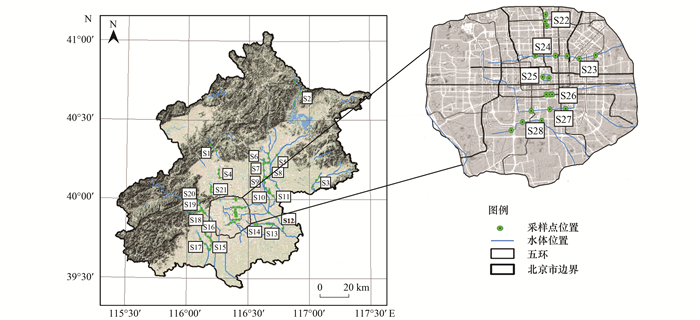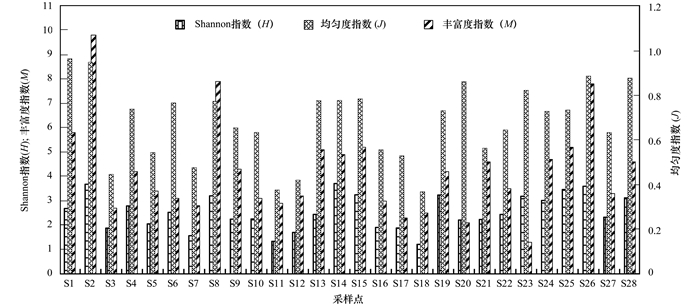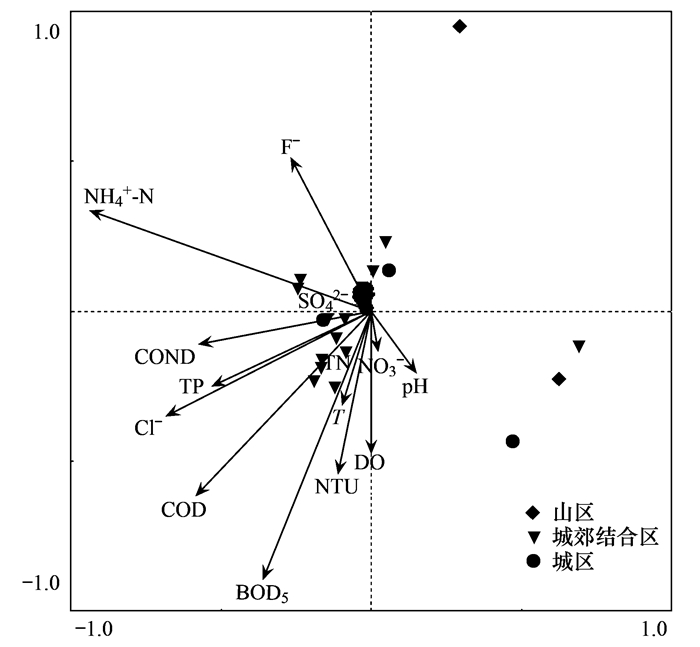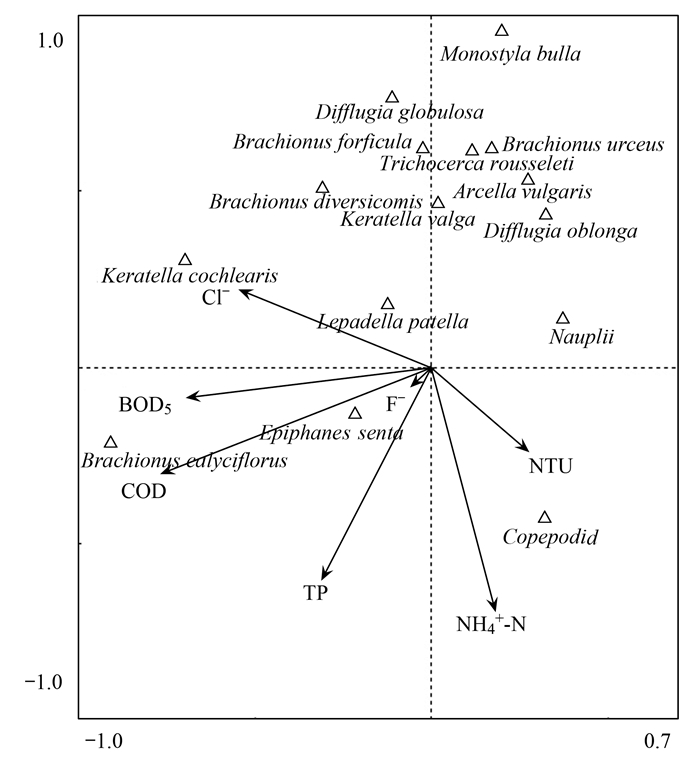2. 中国科学院生态环境研究中心城市与区域生态国家重点实验室, 北京城市生态系统研究站, 北京 100085
2. Beijing Urban Ecosystem Research Station, State Key Laboratory of Urban and Regional Ecology, Research Center for Eco-Environmental Sciences, Chinese Academy of Sciences, Beijing 100085, China
浮游动物是水生生态系统中重要的生物组成部分, 作为初级消费者具有个体小、数量多、代谢旺盛、对环境变化敏感等特点, 是联系初级生产者和高级消费者承上启下的重要一环[1].影响浮游动物群落结构的因素包括非生物因素和生物因素, 非生物因素如营养盐(氮、磷等)、光照、温度、流速和人类活动等, 生物因素如寄生和捕食与竞争等.由于空间环境差异性以及生物之间相互作用的复杂性, 影响浮游生物群落的主导因子在不同水体中也是存在差异[2, 3].此外浮游动物不同特征是不同生境中的不同响应, 其群落特征能客观反映水域生态系统质量状况[4~6], 分析浮游动物群落特征有助于对水质状况做出准确评估, 同时也能弥补理化监测评价部分不足.
河流是城市景观重要组成部分, 对缓解城市热岛效应、维持城市生物多样性、城市给排水有着十分重要的作用[7, 8].人类活动干扰对城市河流水质、水生生物种类组成、分布特征等产生重要影响[9], 目前针对水生生物尤其是浮游动物的研究主要集中于水量充沛的南方地区以及东北高纬度地区[10~18], 海河流域河流浮游动物研究相对较少, 对北京地区河流浮游动物特征研究也限于城区的部分河段或者单个流域[8, 19~21], 对城市整体河流研究鲜见报道.通过对北京市河流水体中浮游动物分布特征以及影响因素研究, 分析浮游动物群落空间特征及其与环境因子之间的关系, 以期为北京市河流水质监测与评价提供基础数据, 对北京市河流水质保护及水生态系统恢复具有重要意义.
1 材料与方法 1.1 研究区概况北京市位于华北平原北部, 西北高, 东南低, 山区面积约占总面积的62%, 平原区面积约占总面积的38%.北京市为典型的北温带半湿润大陆性季风气候, 夏季高温多雨, 冬季寒冷干燥, 春、秋短促.北京市天然河道自西向东贯穿五大水系, 分别为拒马河水系、永定河水系、北运河水系、潮白河水系和蓟运河水系.多由西北部山地发源, 向东南蜿蜒流经平原地区, 最后分别在海河汇入渤海(蓟运河除外).
1.2 采样点选择和采样时间采样点涵盖饮用水水源区、工业用水区、农业用水区和景观娱乐用水区, 共28个采样点, 81个采样断面(每个采样点设置3个采样断面, 长度小于2 km且生境相似的水体设置2个断面)(图 1). 28个采样点分山区水体(S1~S2)、城郊结合区水体(S3~S21)和城区水体(S22~S28).具体河流采样点名称和编号如下:碓石口沟(S1)、白马关河(S2)、平谷新城汝河(S3)、东沙河(S4)、怀河(S5)、牤牛河(S6)、小中河(S7)、顺义城区潮白河(S8)、城北减河(S9)、七分干渠(S10)、月牙河(S11)、北运河通州城市段(S12)、萧太后河改线段(S13)、萧太后河马家湾蓄洪区(S14)、小清河(S15)、哑叭河(S16)、刺猬河(S17)、黑河沟(S18)、门城湖(S19)、龙泉湾河(S20)、东埠头河(S21)、龙形水系(S22)、朝阳区亮马河(S23)、北护城河(S24)、故宫外筒子河(S25)、三里河(S26)、南护城河(S27)和马草河(S28).样品采集和分析时间为2017年9~10月.

|
图 1 监测点位示意 Fig. 1 Locations of the monitoring sites |
使用采水器采集混合水样50 L, 用25号浮游生物网过滤, 将滤取的样本放入100 mL标本瓶中, 加入体积分数为4%~5%的甲醛溶液固定[22].固定后的样本在室内静置48 h后虹吸上清液, 浓缩至30 mL.鉴定时混匀沉淀后的样品, 在100~400倍光学显微镜(Olympus-CX21)下使用1 mL计数板鉴定浮游动物种类、体数量, 换算成密度, 生物量根据浮游动物体积计算[23~25].
1.3.2 环境因子水样采集与测定水温(T)、pH、电导率(COND)、溶解氧(DO)和浊度(NTU)使用便携式YSI水质测定仪现场测量, 透明度(SD)使用赛氏盘测量.采集混合水样1 L, 48 h内带回实验室.参照文献[26]测定总氮(TN)、总磷(TP)、氨氮(NH4+-N)、硝氮(NO3-)、五日生化需氧量(BOD5)、化学需氧量(COD)、氯离子(Cl-)和硫酸根离子(SO42-).
1.4 数据处理方法优势种根据物种的出现频率及个体数量来确定, 用优势度表示:

|
(1) |
式中, Y是优势度, fi是第i物种的出现频率, Pi是第i物种个体数量占总个体数量的比例, 当Y>0.02时, 确定为优势种.
Shannon-Wiener多样性指数(H)、Pielou均匀度指数(J)和Margalef丰富度指数(M)[27]计算均通过BioDiversity Pro 2.0软件包完成.水环境质量评价采用综合水质标识指数法(Iwq)[28~30].数据统计分析使用SPSS 19.0软件包完成, 图件绘制采用Origin 8.0软件包完成, 浮游动物群落与环境因子进行主成分分析(PCA)和典范对应分析(CCA)使用Canoco for Windows 4.5软件包完成.
2 结果与分析 2.1 浮游动物群落特征28个采样点共鉴定出浮游动物4类68种, 均为淡水河流常见种, 其中原生动物17种占25%, 轮虫36种占53%, 枝角类13种占19%, 桡足类占3%, 主要是桡足幼体和无节幼体.城区及城郊结合区水体中以轮虫为主, 臂尾轮虫属、龟甲轮虫属种类占据优势; 山区水体中原生动物、轮虫、桡足类均有检出, 物种种类为山区<城区<城郊结合区.优势种在山区以原生动物、桡足类为主, 在城郊结合区以桡足类为主, 在城区以轮虫为主(见表 1). 28个采样点中, 未出现枝角类的优势种, 在北运河城市段(S12)、萧太后河该线段(S13)、黑河沟(S18)、亮马河(S23)和马草河(S28)未检出枝角类.
|
|
表 1 水体间浮游动物优势种1) Table 1 Dominant species of zooplankton in different waters |
各采样点生物量及密度空间分布如图 2所示, 从中可知浮游动物密度、生物量及物种组成呈现城郊结合区水体(S3~S21)>城区水体(S22~S28)>山区水体(S1~S2)的空间分布特征.浮游动物中桡足类密度最大, 达到398.2 ind. ·L-1, 其中平谷新城汝河(S3)贡献了40.2%, 其次为轮虫374.6 ind. ·L-1, 原生动物为54.2 ind. ·L-1, 枝角类最小33.2 ind. ·L-1.浮游动物密度和生物量最大值出现在平谷新城汝河(S3), 分别为203.2 ind. ·L-1和1 633 μg ·L-1, 最小出现在昌平碓石口(S1)采样点, 分别为1.7 ind. ·L-1和8.8 μg ·L-1.

|
图 2 各采样点浮游动物平均密度与生物量 Fig. 2 Average density and biomass of zooplankton for the different sampling sites |
Shannon-Wiener多样性指数(H)、Margalef丰富度指数(M)、Pielou均匀度指数(J)计算结果分别介于1.21~3.71、1.3~9.8和0.37~0.96之间(图 3), 均呈现山区(S1~S2)>城区(S22~S28)>城郊结合区(S3~S21). 28个采样点中, Shannon-Wiener多样性指数平均值为2.54, 根据Shannon-Wiener指数的评价标准(0~1重污染、1~2为α-中污型、2~3为β-中污型、3~4.5为轻污染、>4.5为清洁水体), 北京市大多数水体处于β-中污染和轻污染之间.结合均匀性指数和丰富度指数计算结果可知, 采样点S7、S11、S12和S18相比于北京市其他采样点, 水质状况相对较差, 水体环境更应受到相关管理部门重视.

|
图 3 各采样点浮游动物多样性指数、均匀度指数和丰富度指数 Fig. 3 Diversity index, evenness index, and richness index of zooplankton at the different sampling sites |
水环境质量评价采用综合水质标识指数法, 结果如表 2所示.北京市水体综合水质标识指数Iwq= 3.4, 为Ⅲ类水质.其中:山区2.8, 为Ⅱ类水质; 城郊结合区4.0, 为Ⅳ水质; 城区为3.3, 为Ⅲ类水质.依据单因子标识指数法和综合水质标识指数法原理[27~29], 判别出影响北京市河流水体的主要污染因子为TN, 其次为TP和COD. 28个采样点中, S4最为突出, TN劣于功能区8个类别.山区河流水环境影响因子是TN, 两个采样点均劣于功能区5个级别以上; 影响城郊结合区河流水环境因子为TN、TP、NH4+-N和COD, 城区河流水体绝大部满足水功能区要求.总体上, 北京市河流水体水质空间分布呈现山区优于城区, 城区优于城郊结合区.
|
|
表 2 综合水质标识指数法水质评价结果1) Table 2 Evaluation results of water quality using the comprehensive water quality index method |
2.3 浮游动物群落结构与环境因子的关系
采样点水环境因子PCA分析结果表明, 28个采样点水环境存在明显差异(图 4).在浮游动物群落结构中起主要影响作用的环境因子包括NTU、TP、NH4+-N、BOD5、COD、F-和Cl-.依据PCA分析结果, 对这7个环境因子和浮游动物优势种群落进行CCA分析, 结果如图 5所示.第一排序轴特征值λ=0.40, 物种与环境因子相关系数为0.89;第二排序轴λ=0.21, 物种与环境因子相关系数为0.82, 表明排序能够较好地反映浮游动物与水环境因子间的相互关系. BOD5、COD和Cl-是第一排序轴的重要影响因子, BOD5和COD与第一排序轴相关性较大, 与大多数优势种密度呈显著负相关(P<0.05), 相关系数分别为-0.62和-0.69;其他因子的相关性较小(NTU:0.25、TP:-0.28、NH4+-N:0.16、F-:-0.06、Cl-:-0.49).与第二排序轴显著相关的水环境因子为NH4+-N, 相关系数为-0.56, 与大多数优势种密度呈显著负相关(P<0.05), 其他因子的相关性较小(NTU:-0.20、TP:-0.50、BOD5:-0.07、COD:-0.25、F-:-0.05、Cl-:0.19).因此, 影响北京市河流浮游动物群落结构主要环境因子为NH4+-N、BOD5和COD, 均呈现负相关关系, 即大多数浮游动物优势种密度随着NH4+-N、BOD5和COD浓度升高而降低.

|
图 4 水体间环境因子PCA排序 Fig. 4 PCA sequence diagram of water environmental factors |

|
图 5 水体间浮游动物与环境因子CCA排序 Fig. 5 CCA sorting diagram of zooplankton and environmental factors |
北京市浮游动物密度及生物量主要取决于轮虫和桡足类, 对浮游动物总密度和生物量起决定性作用. 28个采样点浮游动物物种组成大多以轮虫为主, 与大多数亚热带水体中浮游动物物种组成结构相似, 这是由河流浮游动物组成的特异性决定的[31, 32].常见的轮虫为雌体, 且这种雌体通常以孤雌生殖繁衍其后代, 具有个体小、周期短、发育快等特点, 能快速适应河流中理化环境的改变和水文条件的变化, 因此在河流生境中轮虫常居优势地位[33, 34].
一般而言, 优势种种类数及其丰度对群落结构的稳定性有重要作用, 且优势种种类越多, 优势度越小, 群落结构越稳定.此次调查发现, 城区水体(S22~S28)优势种多为臂尾轮虫属、龟甲轮虫属, 为富营养水体指示物种[35~37], 表明城区水体氮磷含量较高.城郊结合区和山区水体中(S3~S21), 优势种类则以桡足类为主, 桡足类可以在各种生态系统中存活, 也是高盐度富营养水体中最丰富的群体[38, 39].山区水体(S1~S2)优势种为表壳虫、砂壳虫等贫营养水体指示生物.造成这种空间分布特征的原因主要是城区及城郊结合区周边土地利用和土地覆盖类型不同, 城区和城郊结合区受人类活动干扰强烈, 人口密度大, 河流易受到污染[40].
与前人研究结果比较后发现, 2009年后浮游动物多样性指数小于此次调查结果(表 3), 北京市水体浮游动物多样性指数在升高, 从浮游动物多样性指数变化来看北京市水体水质整体上在改善.
|
|
表 3 相关研究与本次研究结果对比 Table 3 Comparison of results between existing research and this study |
3.2 水质空间分布影响因素分析
水体综合水质标识指数及浮游动物多样性指数均显示城郊结合区水体水质(S3~S21)劣于城区水体(S22~S28)和劣于山区水体(S1~S2). Villegas等[9]的研究发现, 政府河湖管理策略对水体中浮游动物特征起到重要影响.城市发展过程中配套设施逐步完善, 点源污染逐渐得到控制, 非点源污染逐渐成为城市水体中主要污染源[41~43].在城郊结合区河流中, 由于监管盲区及水处理措施不到位, 生活污水排放, 导致其水体水质部分劣于水体功能区类别[44~46].
3.3 浮游动物群落影响因素分析水环境质量决定生物种群的群落结构特征, 而生物密度和生物量变化客观反映出水质变化规律[47].对浮游动物群落与水环境因子进行主成分分析(PCA)和典范对应分析(CCA)发现, 北京市水体中浮游动物优势种与NH4+-N、COD和BOD5等密切相关.水体氮、磷决定着浮游植物含量高低, 也就间接决定着浮游动物数量的多寡[48, 49]. 28个水体中轮虫数量与NH4+-N浓度呈显著负相关, 而桡足类与NH4+-N呈正相关关系, 而NH4+-N含量指示水体内营养盐水平[50], 由于过高的营养盐会抑制以浮游藻类为食的浮游动物物种及生物量[51], 轮虫主要以浮游藻类、细菌和腐殖质为食[52], 因此在城郊结合区优势种为桡足类.桡足类在能量和物质流动和生物地球化学循环中起重要作用[53], 能够应对各种环境变化[54, 55], 这种能力使它们能够在各种极端环境中得以生存, 因此在山区相对清洁的水体呈现原生动物和桡足类为优势种.研究发现, 北京市河流营养盐含量呈现城郊结合区>城区>山区的分布特征, 与浮游动物密度、生物量、多样性指数、综合水质标识指数分布特征一致.营养盐不仅能通过影响浮游植物生长来影响浮游动物, 而且通过渗透和离子调节机制影响浮游动物生长繁殖[56], 这一点在营养盐水平过高的小中河(S7)、月牙河(S11)水体中浮游动物特征及生物多样性分析结果得到体现.
CCA分析表明, BOD5和COD在一定程度上与城区的臂尾轮虫和龟甲轮虫优势群落呈负相关. COD可以间接反映水体富营养化程度[57], 研究中发现水体COD浓度呈现城郊结合区水体>城区水体>山区水体的分布特征. BOD5浓度较小, 没有明显的分布特征. COD浓度整体上反映水体中有机质水平, 而BOD则反映水体中有机质能被生物利用的部分[58]. Ning等[59]对两条互不干扰河流, 一条人为干扰河流, 另一条自然河流研究后发现, 受人为干扰的河流会因水体缺氧导致水体黑臭, 浮游动物受到抑制.山区水体生境趋近自然, 岸边基本被森林覆盖, 林地通过过滤、吸收等作用将地表径流中的营养物截留, 同时岸边大量植物根部的微生物通过矿化、转化等作用降低了水体离子及营养物浓度[60, 61], 有效地保护了水体水质.如此同时, 水体中营养物质缺乏也影响了水体中浮游动物的数量.城区及城郊结合区河流, 河道边坡硬质化, 切断了河流与河岸土壤中水分及营养物之间的交换[62, 63].同时, 由于城市地表径流、污水管网泄漏, 以及部分未经处理的城市污水携带污染物进入河道中, 引起城市水体水质恶化, 并对浮游动物产生影响[64], 这种影响在水体污染相对较轻时有利于浮游动物的生长繁殖, 随着污染加重, 变为不利于浮游生物生长繁殖, 但具体的分界线或者说阈值是多少, 目前仍不清楚, 需要进一步研究.北京市河流水体水质大部分都能达到水体功能区要求, 少量不符合水功能区要求的水体污染也相对较轻, 因此城郊结合区河流水体浮游动物数量较高, 而山区河流水体浮游动物数量较低.
4 结论(1) 北京市28个采样点共鉴定出浮游动物4类68种, 其中原生动物17种占25%, 轮虫36种占53%, 枝角类13种占19%, 桡足类鉴定出桡足幼体和无节幼体, 15种优势种主要来自于轮虫和桡足类, 在山区以原生动物和桡足类为主, 在城郊结合区以桡足类为主, 在城区以轮虫为主. NH4+-N、BOD5和COD是影响浮游动物特征的主要水环境因子.
(2) 北京市大部分水体处于β-中污染~轻度污染之间, 水环境质量呈现山区水体优于城区水体优于城郊结合区水体的分布特征, 影响北京市水体的主要污染因子为TN.
| [1] | Ger K A, Urrutia-Cordero P, Frost P C, et al. The interaction between cyanobacteria and zooplankton in a more eutrophic world[J]. Harmful Algae, 2016, 54: 128-144. DOI:10.1016/j.hal.2015.12.005 |
| [2] | Šorf M, Davidson T A, Brucet S, et al. Zooplankton response to climate warming:a mesocosm experiment at contrasting temperatures and nutrient levels[J]. Hydrobiologia, 2015, 742(1): 185-203. DOI:10.1007/s10750-014-1985-3 |
| [3] |
王松波, 余俊爽, 曹艳敏, 等. 光照和营养盐对浮游动物和浮游植物生物量及其营养联系的影响[J]. 生态环境学报, 2018, 27(6): 1122-1127. Wang S B, Yu J S, Cao Y M, et al. Light and nutrients as determinants of zooplankton and phytoplankton biomass and their impacts on pelagic trophic linkage[J]. Ecology and Environmental Sciences, 2018, 27(6): 1122-1127. |
| [4] | Bonecker C C, Simões N R, Minte-Vera C V, et al. Temporal changes in zooplankton species diversity in response to environmental changes in an alluvial valley[J]. Limnologica, 2013, 43(2): 114-121. DOI:10.1016/j.limno.2012.07.007 |
| [5] |
刘歆璞, 王丽卿, 张宁, 等. 青草沙水库后生浮游动物群落结构及其与环境因子的关系[J]. 生态学杂志, 2013, 32(5): 1238-1248. Liu X P, Wang L Q, Zhang N, et al. Community structure of metazoan zooplankton and its relationships with environmental factors in Qingcaosha Reservoir of Shanghai, East China[J]. Chinese Journal of Ecology, 2013, 32(5): 1238-1248. |
| [6] |
王文侠, 陈非洲, 谷孝鸿. 南京市5座中型水库浮游动物群落结构及其与环境因子的关系[J]. 湖泊科学, 2017, 29(1): 216-223. Wang W X, Chen F Z, Gu X H. Community structures of zooplankton and its relation to environmental factors in five medium reservoirs in Nanjing City[J]. Journal of Lake Sciences, 2017, 29(1): 216-223. |
| [7] | Shen Z Y, Hou X S, Li W, et al. Relating landscape characteristics to non-point source pollution in a typical urbanized watershed in the municipality of Beijing[J]. Landscape and Urban Planning, 2014, 123: 96-107. DOI:10.1016/j.landurbplan.2013.12.007 |
| [8] |
顾晓昀, 徐宗学, 刘麟菲, 等. 北京北运河河流生态系统健康评价[J]. 环境科学, 2018, 39(6): 2576-2587. Gu X Y, Xu Z X, Liu L F, et al. Health assessment of the stream ecosystem in the north canal river basin, Beijing, China[J]. Environmental Science, 2018, 39(6): 2576-2587. |
| [9] | Villegas P P, Caiola N, Ibáñez C. Water management alters phytoplankton and zooplankton communities in Ebro delta coastal lagoons[J]. Limnetica, 2017, 36(1): 113-126. |
| [10] |
方艳红, 黄道明, 王文君, 等. 大渡河河口秋季浮游动物的群落结构特征[J]. 水生态学杂志, 2012, 33(3): 34-40. Fang Y H, Huang D M, Wang W J, et al. Characteristics of community structure of zooplankter in autumn at estuary of Dadu River[J]. Journal of Hydroecology, 2012, 33(3): 34-40. |
| [11] |
高原, 赖子尼, 李捷, 等. 连江浮游动物多样性的空间分布[J]. 生物多样性, 2013, 21(6): 699-708. Gao Y, Lai Z N, Li J, et al. Spatial pattern of zooplankton diversity in Lianjiang River, Guangdong Province, China[J]. Biodiversity Science, 2013, 21(6): 699-708. |
| [12] |
高原, 赖子尼, 杨婉玲, 等. 2014~2015年珠江春季禁渔前后浮游动物群落变化[J]. 生态环境学报, 2017, 26(9): 1562-1569. Gao Y, Lai Z N, Yang W L, et al. Changes of zooplankton community before and after the spring closed season in the Pearl River in 2014-2015[J]. Ecology and Environmental Sciences, 2017, 26(9): 1562-1569. |
| [13] |
鞠永富, 于洪贤, 于婷, 等. 松花江哈尔滨段浮游动物群落结构特征与水质评价[J]. 湖泊科学, 2017, 29(3): 646-653. Ju Y F, Yu H X, Yu T, et al. Zooplankton community structure characters and water quality assessment in Harbin section of Songhua River[J]. Journal of Lake Sciences, 2017, 29(3): 646-653. |
| [14] |
彭秋志, 廖剑宇, 伍凯, 等. 东江支流夏季小型浮游动物群落特征研究[J]. 资源科学, 2013, 35(3): 481-487. Peng Q Z, Liao J Y, Wu K, et al. Aestival characteristics of small zooplankton communities in the main tributaries of the Dongjiang River[J]. Resources Science, 2013, 35(3): 481-487. |
| [15] |
王璐璐, 董芳, 李芳芳, 等. 大辽河水系夏季后生浮游动物群落结构及水生态评价[J]. 生态学杂志, 2013, 32(2): 389-395. Wang L L, Dong F, Li F F, et al. Metazoan zooplankton community structure and aquatic ecology of Daliaohe River, North China in summer[J]. Chinese Journal of Ecology, 2013, 32(2): 389-395. |
| [16] |
吴利, 李源玲, 陈延松. 淮河干流浮游动物群落结构特征[J]. 湖泊科学, 2015, 27(5): 932-940. Wu L, Li Y L, Chen Y S. Characteristics of community structures of zooplankton in the mainstream of Huaihe River[J]. Journal of Lake Sciences, 2015, 27(5): 932-940. |
| [17] |
叶又茵, 王雨, 林茂. 九龙江河口浮游动物的群落结构和时空变动[J]. 生态科学, 2013, 32(4): 408-419. Ye Y Y, Wang Y, Lin M. Community structure and spatial-temporal variation of zooplankton in Jiulongjiang Estuary of Xiamen, China[J]. Ecological Science, 2013, 32(4): 408-419. |
| [18] |
郑金秀, 池仕运, 李聃, 等. 三峡水库运行期间原生动物群落的时空异质性[J]. 生态学报, 2015, 35(11): 3569-3579. Zheng J X, Chi S Y, Li D, et al. Spatio-temporal heterogeneity of protozoan communities during the period of Three Gorges Reservoir operation[J]. Acta Ecologica Sinica, 2015, 35(11): 3569-3579. |
| [19] |
曾阳, 苗明升, 付秀娥, 等. 温榆河浮游动物多样性及水质改善效果评价[J]. 环境科学与技术, 2012, 35(3): 200-205. Zeng Y, Miao M S, Fu X E, et al. Evaluation of water quality improvement in Wenyuhe River based on the analysis of diversity of macro-zooplankton[J]. Environmental Science & Technology, 2012, 35(3): 200-205. DOI:10.3969/j.issn.1003-6504.2012.03.043 |
| [20] |
李莉娜, 陈卫, 高思佳, 等. 北京白河与温榆河浮游动物调查[J]. 四川动物, 2008, 27(5): 802-804. Li L N, Chen W, Gao S J, et al. Zooplankton investigation in Baihe River and Wenyuhe River of Beijing[J]. Sichuan Journal of Zoology, 2008, 27(5): 802-804. |
| [21] |
李学军, 鲍战猛, 高彩凤, 等. 北运河浮游动物调查及水质评价[J]. 生态学杂志, 2014, 33(6): 1559-1564. Li X J, Bao Z M, Gao C F, et al. Zooplankton investigation and water quality evaluation in Beiyun River[J]. Chinese Journal of Ecology, 2014, 33(6): 1559-1564. |
| [22] | 孟伟, 张远, 渠晓东, 等. 河流生态调查技术方法[M]. 北京: 科学出版社, 2011. |
| [23] | 韩茂森. 淡水浮游生物图谱[M]. 北京: 农业出版社, 1980. |
| [24] | 王家楫. 中国淡水轮虫志[M]. 北京: 科学出版社, 1961. |
| [25] | 赵文. 水生生物学[M]. 北京: 中国农业出版社, 2005. |
| [26] | 国家环境保护总局. 水和废水监测分析方法[M]. (第四版). 北京: 中国环境科学出版社, 2002. |
| [27] |
李共国, 包薇红, 徐石林, 等. 甬江干流浮游动物群落结构季节动态与水环境的关系[J]. 水生生物学报, 2015, 39(1): 1-12. Li G G, Bao W H, Xu S L, et al. Seasonal change of zooplankton communities and its relationship with aquatic environments in the Yongjiang River, Ningbo[J]. Acta Hydrobiologica Sinica, 2015, 39(1): 1-12. |
| [28] |
胡成, 苏丹. 综合水质标识指数法在浑河水质评价中的应用[J]. 生态环境学报, 2011, 20(1): 186-192. Hu C, Su D. Application of comprehensive water quality identification index in water quality assessment of Hun River[J]. Ecology and Environmental Sciences, 2011, 20(1): 186-192. DOI:10.3969/j.issn.1674-5906.2011.01.033 |
| [29] |
李名升, 张建辉, 梁念, 等. 常用水环境质量评价方法分析与比较[J]. 地理科学进展, 2012, 31(5): 617-624. Li M S, Zhang J H, Liang N, et al. Comparisons of some common methods for water environmental quality assessment[J]. Progress in Geography, 2012, 31(5): 617-624. |
| [30] |
张欢, 纪桂霞. 综合水质标识指数法在公园湖泊水质评价中的应用[J]. 水资源与水工程学报, 2012, 23(2): 146-150. Zhang H, Ji G X. Application of comprehensive water quality identification index method to water quality assessment of park lakes[J]. Journal of Water Resources & Water Engineering, 2012, 23(2): 146-150. |
| [31] |
李志伟, 崔力拓. 环境因子对唐山湾海域浮游动物群落结构的驱动作用[J]. 应用生态学报, 2017, 28(11): 3797-3804. Li Z W, Cui L T. Environmental control of zooplankton community structure in Tangshan Bay, China[J]. Chinese Journal of Applied Ecology, 2017, 28(11): 3797-3804. |
| [32] |
徐杭英, 于海燕, 韩明春, 等. 浙江饮用水源地浮游动物群落特征及环境响应[J]. 生态学报, 2015, 35(21): 7219-7228. Xu H Y, Yu H Y, Han M C, et al. Characteristics of the zooplankton community and their association with environmental factors in drinking water sources, Zhejiang Province, China[J]. Acta Ecologica Sinica, 2015, 35(21): 7219-7228. |
| [33] |
吴利, 冯伟松, 张堂林, 等. 湖北省西凉湖浮游动物群落周年动态变化及其与环境因子的关系[J]. 湖泊科学, 2011, 23(4): 619-625. Wu L, Feng W S, Zhang T L, et al. The annual fluctuation of zooplankton community and its relation with environmental fac-tors in Lake Xiliang, Hubei Province[J]. Journal of Lake Sciences, 2011, 23(4): 619-625. |
| [34] | Gabaldón C, Devetter M, Hejzlar J, et al. Repeated flood disturbance enhances rotifer dominance and diversity in a zooplankton community of a small dammed mountain pond[J]. Journal of Limnology, 2017, 76(2): 292-304. |
| [35] |
许宝红, 肖调义, 金红春, 等. 利用浮游动物评价不同类型养殖水体营养状况[J]. 淡水渔业, 2011, 41(1): 10-15. Xu B H, Xiao T Y, Jin H C, et al. Nutrition evaluation of different aquatic water by zooplankton[J]. Freshwater Fisheries, 2011, 41(1): 10-15. DOI:10.3969/j.issn.1000-6907.2011.01.002 |
| [36] |
罗梅, 赵龙飞, 郑月, 等. 城市景观河道营养状况与轮虫群落结构[J]. 环境工程学报, 2016, 10(9): 4994-5000. Luo M, Zhao L F, Zheng Y, et al. Nutritional status and community structure of rotifer in the riverway of urban landscape[J]. Chinese Journal of Environmental Engineering, 2016, 10(9): 4994-5000. |
| [37] | Lopes P M, Bozelli R, Bini L M, et al. Contributions of airborne dispersal and dormant propagule recruitment to the assembly of rotifer and crustacean zooplankton communities in temporary ponds[J]. Freshwater Biology, 2016, 61(5): 658-669. DOI:10.1111/fwb.12735 |
| [38] | Khemakhem H, Elloumi J, Moussa M, et al. The concept of ecological succession applied to phytoplankton over four consecutive years in five ponds featuring a salinity gradient[J]. Estuarine, Coastal and Shelf Science, 2010, 88(1): 33-44. DOI:10.1016/j.ecss.2010.02.019 |
| [39] | Horváth Z, Vad C F, Tóth A, et al. Opposing patterns of zooplankton diversity and functioning along a natural stress gradient:when the going gets tough, the tough get going[J]. Oikos, 2014, 123(4): 461-471. DOI:10.1111/more.2014.123.issue-4 |
| [40] |
陈向, 周伟奇, 李伟峰. 北京河流底栖硅藻沿城乡梯度带空间分布及其季节变化[J]. 生态学报, 2017, 37(10): 3586-3595. Chen X, Zhou W Q, Li W F. Benthic diatom assemblages and their seasonal variation in streams along an urban-rural gradient in the Beijing metropolitan area[J]. Acta Ecologica Sinica, 2017, 37(10): 3586-3595. |
| [41] | Shen Z Y, Zhong Y C, Huang Q, et al. Identifying non-point source priority management areas in watersheds with multiple functional zones[J]. Water Research, 2015, 68: 563-571. DOI:10.1016/j.watres.2014.10.034 |
| [42] | Stefanakis A, Akratos C S, Tsihrintzis V A. Vertical flow constructed wetlands:eco-engineering systems for wastewater and sludge treatment[M]. Amsterdam: Elsevier, 2014. |
| [43] |
李延, 单保庆, 唐文忠, 等. 北京市典型城市河流(凉水河)沉积物耗氧污染特征[J]. 环境工程学报, 2017, 11(9): 5065-5070. Li Y, Shan B Q, Tang W Z, et al. Pollution characteristic of sediment oxygen demand in typical urban river (Liangshui River) of Beijing city, China[J]. Chinese Journal of Environmental Engineering, 2017, 11(9): 5065-5070. |
| [44] |
王洪涛, 张俊华, 丁少峰, 等. 开封城市河流表层沉积物重金属分布、污染来源及风险评估[J]. 环境科学学报, 2016, 36(12): 4520-4530. Wang H T, Zhang J H, Ding S F, et al. Distribution characteristics, sources identification and risk assessment of heavy metals in surface sediments of urban rivers in Kaifeng[J]. Acta Scientiae Circumstantiae, 2016, 36(12): 4520-4530. |
| [45] |
孟祥巍, 许学工. 平原城市河流面源污染研究范围及方法的选择与效果比较[J]. 生态环境学报, 2014, 23(1): 145-150. Meng X W, Xu X G. The studied area selection and result comparison of river non-point source pollution in plain urban area[J]. Ecology and Environmental Sciences, 2014, 23(1): 145-150. DOI:10.3969/j.issn.1674-5906.2014.01.021 |
| [46] |
丁劲, 李怀恩, 刘铁龙, 等. 河流上下游控制断面非点源污染特征的分析[J]. 水资源与水工程学报, 2015, 26(6): 26-29. Ding J, Li H N, Liu T L, et al. Analysis of non-point source pollution characteristics in control sections of upstream and downstream river[J]. Journal of Water Resources & Water Engineering, 2015, 26(6): 26-29. |
| [47] | Lin Q Q, Xu L, Hou J Z, et al. Responses of trophic structure and zooplankton community to salinity and temperature in Tibetan lakes:implication for the effect of climate warming[J]. Water Research, 2017, 124: 618-629. DOI:10.1016/j.watres.2017.07.078 |
| [48] | Ka S, Mendoza-Vera J M, Bouvy M, et al. Can tropical freshwater zooplankton graze efficiently on cyanobacteria?[J]. Hydrobiologia, 2012, 679(1): 119-138. DOI:10.1007/s10750-011-0860-8 |
| [49] | 章宗涉, 黄祥飞. 淡水浮游生物研究方法[M]. 北京: 科学出版社, 1991. |
| [50] |
文帅龙, 龚琬晴, 吴涛, 等. 于桥水库沉积物-水界面氮磷剖面特征及交换通量[J]. 环境科学, 2018, 39(5): 2154-2164. Wen S L, Gong W Q, Wu T, et al. Distribution characteristics and fluxes of nitrogen and phosphorus at the sediment-water interface of Yuqiao Reservoir[J]. Environmental Science, 2018, 39(5): 2154-2164. |
| [51] | Kozak A, Goldyn R, Dondajewska R, et al. Changes in phytoplankton and water quality during sustainable restoration of an Urban lake used for recreation and water supply[J]. Water, 2017, 9(9): 713. DOI:10.3390/w9090713 |
| [52] | Virro T, Haberman J, Haldna M, et al. Diversity and structure of the winter rotifer assemblage in a shallow eutrophic northern temperate Lake Võrtsjärv[J]. Aquatic Ecology, 2009, 43(3): 755-764. DOI:10.1007/s10452-009-9276-1 |
| [53] | Lorda J F, Fowler S W, Miquel J C, et al. 210Po/210Pb dynamics in relation to zooplankton biomass and trophic conditions during an annual cycle in northwestern Mediterranean coastal waters[J]. Journal of Environmental Radioactivity, 2013, 115: 43-52. DOI:10.1016/j.jenvrad.2012.07.003 |
| [54] | Marques S C, Pardal M A., Mendes S, et al. Using multitable techniques for assessing the temporal variability of species-environment relationship in a copepod community from a temperate estuarine ecosystem[J]. Journal of Experimental Marine Biology and Ecology, 2011, 405(1-2): 59-67. DOI:10.1016/j.jembe.2011.05.015 |
| [55] | Ladhar C, Tastard E, Casse N, et al. Strong and stable environmental structuring of the zooplankton communities in interconnected salt ponds[J]. Hydrobiologia, 2015, 743(1): 1-13. DOI:10.1007/s10750-014-1998-y |
| [56] | Kuczyńska-Kippen N, Joniak T. Zooplankton diversity and macrophyte biometry in shallow water bodies of various trophic state[J]. Hydrobiologia, 2016, 774(1): 39-51. DOI:10.1007/s10750-015-2595-4 |
| [57] |
杨斌, 钟秋平, 张晨晓, 等. 钦州湾海水中石油烃时空变化特征及其影响因素[J]. 海洋科学, 2016, 40(1): 76-84. Yang B, Zhong Q P, Zhang C X, et al. Spatiotemporal variations of petroleum hydrocarbon and its influencing factors in seawater of Qinzhou Bay[J]. Marine Sciences, 2016, 40(1): 76-84. |
| [58] |
何琦, 雷腊梅, 韩博平, 等. 城市有机污染河流后生浮游动物分布特征[J]. 水文, 2009, 29(S1): 168-173. He Q, Lei L M, Han B P, et al. Metazooplankton distribution in urban organic pollution rivers[J]. Journal of China Hydrology, 2009, 29(S1): 168-173. |
| [59] | Ning N S P, Gawne B, Cook R A, et al. Zooplankton dynamics in response to the transition from drought to flooding in four Murray-darling basin rivers affected by differing levels of flow regulation[J]. Hydrobiologia, 2013, 702(1): 45-62. DOI:10.1007/s10750-012-1306-7 |
| [60] | Dosskey M G, Vidon P, Gurwick N P, et al. The Role of riparian vegetation in protecting and improving chemical water quality in streams[J]. Journal of the American Water Resources Association, 2010, 46(2): 261-277. DOI:10.1111/j.1752-1688.2010.00419.x |
| [61] | Groffman P M, Boulware N J, Zipperer W C, et al. Soil nitrogen cycle processes in urban riparian zones[J]. Environmental Science & Technology, 2002, 36(21): 4547-4552. |
| [62] | Hopkins K G, Morse N B, Bain D J, et al. Assessment of regional variation in streamflow responses to urbanization and the persistence of physiography[J]. Environmental Science & Technology, 2015, 49(5): 2724-2732. |
| [63] |
陈利顶, 齐鑫, 李芬, 等. 城市化过程对河道系统的干扰与生态修复原则和方法[J]. 生态学杂志, 2010, 29(4): 805-811. Chen L D, Qi X, Li F, et al. Disturbances of urbanization to river course system and related ecological restoration principles and approaches[J]. Chinese Journal of Ecology, 2010, 29(4): 805-811. |
| [64] | Walsh C J, Roy A H, Feminella J W, et al. The urban stream syndrome:current knowledge and the search for a cure[J]. Journal of the North American Benthological Society, 2005, 24(3): 706-723. DOI:10.1899/04-028.1 |
 2019, Vol. 40
2019, Vol. 40


